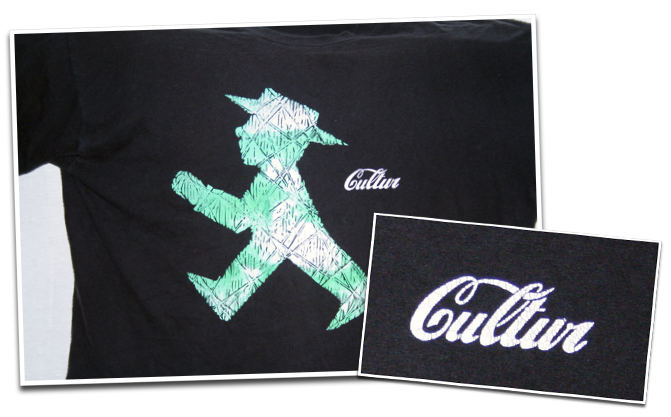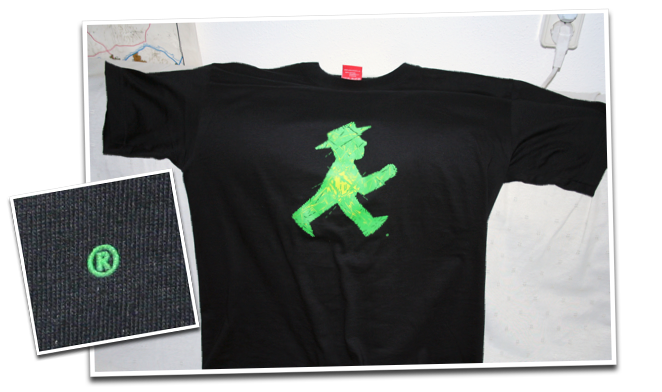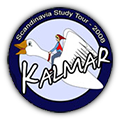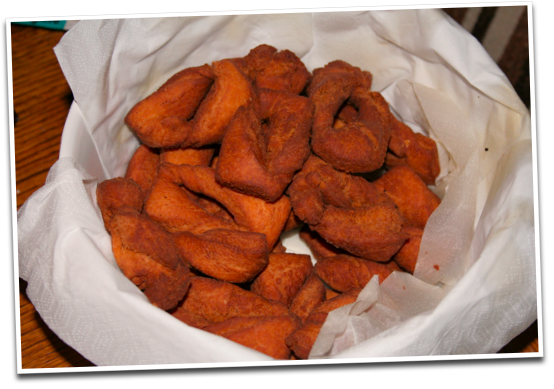-
From Cultur to Commerz
Lees verder
Ampelmann anno 1998
Ampelmann anno 2007Ampelmann became big business in little more than a few years. Back then, a t-shirt was all you could get. Now there are mouse pads, ice cubes, reflectors, bags, et cetera. Back then the shirt was a protest against the Westernisation of the traffic lights in former East-Berlin. Now it is just another souvenir, be it one with history.
-
Rivella coming to Europe!
Lees verderYeeeh, Rivella is going to be marketed throughout Europe, according to the readers of Frank-ly! (Hint: whois drinkme.nl, Heineken is owner of Vrumona, thanks to the research-fu of the visitors of Frank-ly ;-))
Update: Yes! As a little ‘thank you’ note for all the free advertisement, Vrumona decided to put the stuff in new soft PET bottles (yuck) and raised the price by 20%! Hooray! As a side note, Schweppes’ stuff is also affected by this.
-
Go Mentos á Sprengisandi
Lees verderWhile it is not very uncommon to see advertisers go to Iceland to use the magnificient landscape as a backdrop for their productions (Axe also does it= for their self-tanning body lotion stuff by the way), it is pretty uncommon to hear Icelandic folksongs on Dutch television.
Mentos in their new series of demonstrating the freshness of their stuff show the people of Grundafjurdhuhurdhur (actually there is a town called Grundarfjörður on the Snæfellsnes peninsula) involved in some refreshing bath in the fjord filled with Mentosessess (pun intended).
Another installment shows the refreshing of some guy’s mouth by first throwing a bucket over his head to protect the others from the bad smell and then hanging him in some construction to put him headfirst in a tub filled with Mentosses.
Anyway, the song they sing at the end is a song about a horseback tour through the Sprengisandur desert. It’s called á Sprengisandi and was written by Grímur Thomsen who lived from 1820 to 1896:
Ríðum, ríðum og rekum yfir sandinn,
rennur sól á bak við Arnarfell,
hér á reiki er margur óhreinn andinn,
úr því fer að skyggja á jökulsvell;
Drottinn leiði drösulinn minn,
drjúgur verður síðasti áfanginn.Þey þey! þey þey! Þaut í holti tóa,
þurran vill hún blóði væta góm,
eða líka einvher var að hóa
undarlega digrum karlaróm.
útilegumenn í ódáðahraun
eru kannski að smala fé á laun.Ríðum, ríðum og rekum yfir sandinn,
rokkrið er að síga á Herdubreið
álfadrottning er að beisla gandinn,
ekki er gott að verða á hennar leið
Vænsta klárinn vildi ég gefa til
að vera kominn ofan í Kiðagil.The first strophe roughly translates to:
Ride, ride, ride over the sand,
Run with the sun behind Arnarfell,
Bad spirits/winds come and go here.
Dusk is falling on the gletscher ice,
God leads my horse,
Long will be the last stage.You won’t find a Icelander that doesn’t know this song. It’s quite funny to hear this familiar tune in an advertisement, since we also had it at the Icelandic course last August as part of our cultural programme :-)
-
Bike
Lees verderToday was a great day for just fooling around with a HDV camera… No script, no deeper meanings. Just cycling.
Or should I maybe have called it Bicycle Crash?
-
RSS, two and a half years later
Lees verderTwo and a half years ago I wrote an article (has it been that long, time really flies) about the state and future of RSS. I thought it would be nice to revisit this article and delibrate on the next steps.
The first problem I brought up was the fact that it is a poll system, as opposed to an event-based system. I asserted that if RSS wants to be successful, it has to be converted into a push method. Well, I was quite wrong :-) It turned out to be so successful that there are now companies and services that only publish RSS feeds from other feeds (Feedburner, Yahoo! Pipes).

Something which developed very quickly during the end of 2004 was a thing called podcasting. Audio and video files are enclosed in the RSS feed and can be automatically downloaded by a newsreader or “podcatcher”. Many podcasts exist, most are of questionable quality, but some stand out, just like with written weblogs.
The idea of podcasting caught quite a bit of attention and the relatively simple technology behind it created a slew of more or less successful ideas. Apple thought of photocasting where the iPhoto application creates RSS feeds with an item for each photo that is to be published. Other users of iPhoto can then subscribe to the feed and get automatic updates of others’ photos. It didn’t really catch on, although Flickr is now offering RSS feeds with photos enclosed which can be used with iPhoto (or any other feed reader, for that matter).

In Free Software development circles, a Python script called Planet became popular to aggregate the weblogs of the many developers working on a project. The Hackergotchi, a small picture with or without fancy drop shadow to identify authors of the different posts was born.
The simple way in which RSS feeds can be parsed and extended, thanks to XML, generates new applications every day. RSS no longer is solely a way of delivering blog content to the end user, it isn’t even bound to things happening over time anymore. It has become a standardized way to exchange content of any kind.
It is an important step in the becoming of the semantic web, where every piece of information is put into context and accessible from anywhere using any device. It was a driving force in the success of the Web 2.0 bubble which didn’t burst like the first.
Advertising companies understood the possibilities of RSS and started offering advertisements for inclusion in feeds, either in the form of a banner in the footer of posts, or as advertorials in separate feed items.

Recently, a discussion about the copyrights of feeds came up when some people discovered that their feeds were aggregated by a commercial site which put advertisements in their posts (thereby possibly exercising their fair-use rights). They responded by relicensing the feed under a non-commercial Creative Commons license. They have no problem with people earning money with what they write, they do have a problem with people earning money with their writings without sharing or even telling.
So, what do you think, will the article I will write two and a half years from now still be about RSS? Or will we arrive at a better technology? What will be the challenges for the next years? Will this technology or its successor ever become so user friendly your mother would use it?
I’ve added comments to the site, just follow the link below and leave a message!
Update: I found this little video trying to explain RSS in plain English. I think this still is way too technical, but it’s a start.
-
Tjörnin panorama
Lees verderThis is the last panorama from Iceland I have, made on my last weekend there, when it after some days of frost suddenly started snowing and the frozen-over lake Tjörnin (The Pond) in the center of Reykjavík became a big snowfield.

On the far left, in the distance, the Askja building of the University of Iceland can be seen, where I had my introduction to the Icelandic language and culture in August. On the far right is the modern city hall of the city of Reykjavík.
-
Jökulsárlón panorama revisited
Lees verderAnd yet another series of collected images which become a panoramic image when arranged in the right way… I can’t recall myself making so many of them :D But that’s alright, because panoramas are good.
We’re once again at Jökulsárlón, this time at the other side of the river. You can see the place where the other panorama was taken on the left, on the hill, somewhere around the electricity mast.
On the other picture, you can see a hill next to a little restaurant and amphibious vehicle base (during summer, you can take a trip on the lake between the ice blocks). It’s where I stood and took this one.

The lake looks very different on this side, big blocks float directly (but very, very slowly) into the sea, the smaller ones get trapped in the bay on the other side. The largest blocks can’t get through the narrow stream to sea and have to stay a while to melt away.
-
Gullfoss panorama
Lees verderWhen we were at Gullfoss, the golden waterfall in the river Hvítá (White River), I took a series of photos. They weren’t really intended as a panorama, but I could somewhat stitch them together like I did with the Jökulsárlón panorama.

It has lots of stitching errors, there’s even a person cut in half. Like last time, there is a somewhat bigger version.
-
Hyves
Lees verderOkee, ik heb toegegeven aan de sociale druk van m’n huisgenoten :P
Het is gebeurd, Christian hyvet. Natuurlijk puur uit wetenschappelijke interesse met betrekking tot user-interface-miskleunen.
Even een snelle review van de site: zet Johan stem op Nou, het is een rommelige compositie, chaotische structuur, slecht en onoverzichtelijk spel, dus dat zal wel weer populair worden, maar dat is logiesch.
Serieus, hoe kan zo’n chaos zó populair worden?
-
Drawn! I'm going on the study tour
Lees verder I got a message that finally the draw for the places in the Kalmar study tour took place and that I was in fact drawn to join them.
I got a message that finally the draw for the places in the Kalmar study tour took place and that I was in fact drawn to join them.There is a maximum of 24 participants, 27 subscribed, 13 of which are computer science students and the first 12 of them are placed with the 13th put on hold. I was number 6.
For the remaining 14 mathematics students, case studies will have to be found, but I’m sure they’ll manage.
In the end it will mean that we probably are going with 27 after all.
And now? Now we wait for our case study to come available and the excursions and lectures to prepare for the tour.
-
Visualization finished - Vökvar 1.0.0 released!
Lees verderFinally, after two years, I got my grade for the Visualization course today. Not that great, merely a seven, but well, it’s done.
I decided that Fluids is a boring name, because it is just an English word. So I renamed it Vökvar, which also is just a word, but at least it’s an Icelandic one — intrinsically cooler however — meaning exactly the same.
- [Vökvar 1.0.0 intel]/files/fluids/Vokvar-i386-1.0.0.dmg) (dmg)
- [Vökvar 1.0.0 powerpc]/files/fluids/Vokvar-powerpc-1.0.0.dmg) (dmg)
- [Vökvar 1.0.0 source code]/files/fluids/vokvar-1.0.0.tgz) (tarball)
- [Report]/files/papers/visualization%20-%20fluids.pdf) (pdf)
Update: I forgot that the usage is not at all trivial :)
So, here are some keystrokes that do stuff (they’re also mentioned in the report):
- 1: Switches the “smoke” on and off
- 2: Switches the speed vectors on and off
- 3: Switches the streamlines on and off
- 4: Switches the isolines on and off
- p: Switches between palette (rainbow, rainbow with 5 discrete colours, grayscales)
- o: Switches between isolines method (by value, by number, by point)
- a: Temporarily freeze simulation and animation
- f: Switches to and from fullscreen view
- t/T: Changes timestep
- s/S: Changes scale of vectors and streamlines
- v/V: Changes viscosity
- i/I: Changes number of isolines
- q: Quits Vökvar
-
Kleinur
Lees verderKleinur (sg. kleina) are a tasty type of Icelandic cookie. They’re deep fried, and have a taste reminiscent of grandmother’s apple pie without the apples. So basically they taste like cookie :-)

The recipe is pretty simple, take 85 grams of butter and 200 grams of sugar and mix them. Add an egg, baking powder and baker’s ammonia (I tried to get this here, but failed, even in the biological supermarket and at the local bakery, maybe I’ll try again next time I’m in Germany – they tend to have every possible bakery supply at any supermarket), graped zest of a lemon, some cardamom, and 100 ml yoghurt or buttermilk (actually you should use súrmjólk but that’s unavailable outside Iceland). Mix this very well and add up to 700 grams of flour, preferably less until you have a smooth dough.
Split the dough in a few pieces and flatten them until quite thin, cut 3cm by 6-8cm diamonds, cut a slit diagonally, take one corner and turn it through the slit.
Put the kleinur in a frying pan at 180 degrees, after 1 to 2 minutes they’re nicely brown coloured. Eat hot with cold milk or cold with coffee.
During Jólatíð, so around Christmas, they’re served with chocolate icing. Also very nice.